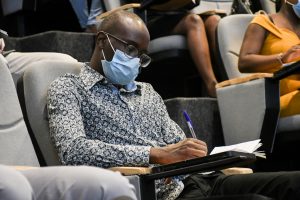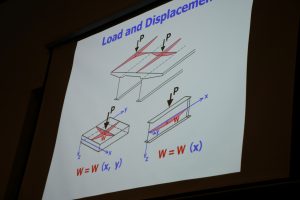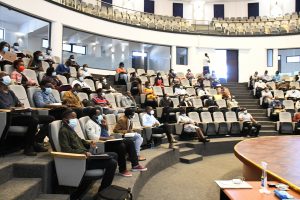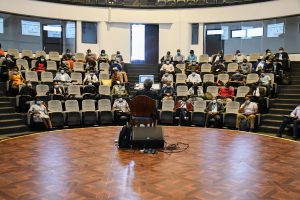CSI STATEMENT
JICA TRAINING
ADB SCHOLARSHIPS
DISABILITY IS NOT INABILITY
OTHER CSI ACTIVITIES
As an Authority, we take cognizance of our responsibility to the communities in which we work with.
Our CSI ethos is hinged on our obligation to act as responsible corporate citizens. We uphold environmental stewardship as one of our core values, and recognize that our activities as an Authority have an impact on the communities we interact with. We are therefore committed to not only creating a positive impact, but to also utilising available resources to impact life positively.
INSPIRING OUR FUTURE
Engineering in Africa finds itself in a very interesting paradox as captured in a World Bank report on “Improving the Quality of Engineering Education and Training in Africa”. Although there is a shortage of engineers, engineering graduates remain unemployed or are underemployed. A key reason for this is the poor quality of engineering education. The implication of this reality bears an immediate burden on Africa’s pressing development needs. If Kenya’s infrastructural developments are to be in step with the economic growth trajectory, there needs to be an adequate and quality supply of local skilled labor.
Cognizant of these facts, KeNHA has collaborated with Japan International Cooperation Agency (JICA) to undertake a crucial empowerment program. In the partnership, KeNHA through the Directorate of Highway Planning and Design (HP&D) is undertaking a number of projects to build technical capacity and enhance technology transfer. Top on the list is JICA program for Management and Capacity Enhancement under the Bridge Management System (BMS) and Detail Design Study of the Mombasa Gate Bridge Project in the Republic of Kenya.
The first fruit of the partnership was seen in the first phase of training that was held on 10th and 11th March 2021. During this time, participants undertook a detailed study on the Mombasa Gate Bridge construction project. The key areas tackled were: a look at historical bridges & accidents, a general overview of a cable-stayed bridge, design of the slab & girders, and wind tunnel test of the Mombasa Gate bridge. Through forums such as these, KeNHA is playing its part in closing the gap. A forum based on a real case study such as the construction of the Mombasa Gate Bridge is a step forward in inspiring new ideas for our future.
As Kenya gears up its development agenda, there is a need to not only increase the number of engineers, but also enhance the skills of the graduate engineers who now exist in a fast-moving age of technology. According to a UNESCO report 2010, developed and industrialized countries have 20-50 scientists and engineers for a population of 10,000 people. It is estimated that a staggering 2.5 million new engineers and technicians will be needed just to achieve a single Millennium Development Goal; that of improved access to clean water and sanitation.
Assistant – Director HPD, Eng. Joan Otike who was part of the coordinating team says that “capacity building programs are very important as the country gears up its development agenda.” She also quotec an inspirational speaker, Corneille Ewango, “Building capacities for the young generation is going to make a better generation and a better future tomorrow for Africa”. Therefore, there is a need to not only increase the number of engineers, but also enhance the skills of graduate engineers who now exist in a fast-moving age of technology.
There is still more to be done to be done in bridging the existing professional gaps, but even Rome was not built in a day. KeNHA is fortunate to be a trailblazer in many areas of its operations. The methods of problem solving being implemented today may have not have been precedented before. Therein lies an opportunity to ignite a spark in the minds of our future engineers.
SCHOLARSHIP PROGRAM UNDERWAY
The quest for education is still a distant dream for youth in Kenya today. While previously, basic reading and writing would suffice in securing meaningful opportunities, today even university graduates are lucky if they can get a permanent job that pays enough to survive the demands of the modern-day Kenya. In Kenya over half of the unemployed labour force have either achieved a primary school or high school level of education. A labour force basic report published by the Kenya National Bureau of Statistics estimates that there are 1.22 million unemployed Kenyans aged between 15 to 34. These trends have consequently prompted the country to embrace a competency-based curriculum designed to better prepare youth for the world as it is. KeNHA is at the forefront of bringing change and creating opportunity through a scholarship programme that is slowly but surely causing waves of change for youth across the country.
Beneficiaries of a scholarship programme under the Kenol - Sagana – Marua Highway Improvement Project (KSMHIP) have been reporting to the various institutions that they were selected to join. The scholarship is a joint initiative birthed by the partnership between the African Development Bank (ADB) and KeNHA. Under the programme, youth residing in the counties that are traversed by the road project were requested to apply for training in local technical training institutions. From Nyeri, Murang’a and Kirinyaga counties, there was an overwhelming reception of applications. A total of 2500 applications were received upon which 750 individuals were called for interviews and a final 322 trainees were selected for the programme.
Among the 322 selected for the Programme, every institution that is part of the program received students from all the three major counties on Nyeri, Murang’a and Kirinyanga. The distribution of students is as follows:
| INSTITUTION | NUMBER | |
| 1. | Nyeri National Polytechnic | 50 |
| 2. | Mathenge Technical Training Institute | 48 |
| 3. | Kaitheri Youth Polytechnic | 46 |
| 4. | Michuki Technical Training Institute | 80 |
| 5. | Mathira Technical and Vocational College | 41 |
| 6. | Sagana Technical Training institute | 57 |
Technical and vocational education training in Kenya provides fertile ground for the acquisition of practical knowledge and skills relevant for productive economic engagement. A 2012 report by the Institute for Economic Affairs (IEA) also showed that the informal sector contributed an estimated 34.3% of GDP, and accounted for 77% of employment in Kenya. The significance of skills imparted through vocational educational training institutions can therefore not be overlooked.
In providing the scholarships, there is plenty to be considered aside from tuition fees. The various technical courses have departmental requirements like tools and protective attire. Other needs include accommodation, transport and meals. All these expenses have been in some way provided for under the scholarship. Nonetheless, there are many more needs that exist in the daily lives of the students most of whom find themselves coming from extremely needy backgrounds. The various institutions of admission have played their part to ensure that the basic needs of the students are met and that they are provided with a conducive environment for learning.
Mrs. Anne N. Mwangi - Chief Principal Nyeri National Polytechnic says that, “this is a very noble initiative by the government through its implementing agency KeNHA. It is a model that should be replicated across more projects.” The Principal of Michuki Technical Training Institute Principal Mr. John Gitonga Ndirangu urged students not to go back home and relax after finishing the 1-year courses. The trainees can take advantage of other programmes offered by government under HELB loans and CDF funds to further their training.
The scholarship program has a trainee representation of individuals from the counties that the project traverses through. These counties include Nyeri, Kirinyaga and Murang'a. Similar programmes are being undertaken in Mombasa County under the Mombasa - Mariakani Highway Project: Lot 1 and in Eldoret under the Eldoret Bypass road project.
This training program which is a partnership between KeNHA and the African Development Bank is aimed at building the economic capabilities through self-development. It is a first step that opens up an opportunity for youth to develop themselves through the acquisition of technical skills.
DISABILITY IS NOT INABILTY
Teddy Wesonga is the face of boldness in a scholarship program being undertaken by the Kenya National Highways Authority (KeNHA) in partnership with the African Development Bank (ADB).
Teddy is deaf, but that did not stop him from applying for the scholarship program that was advertised for youth living along the Mombasa – Kilifi road project.
In an induction meeting that was conducted for the students, Teddy who was selected to Join the Kenya Coast National Polytechnic was keen to take the front seat accompanied by his sign language interpreter who will accompany him throughout the period of his time in school. Through his interpreter Teddy says “let us not look down on anyone living with disability. We are just as capable as anyone else when given the opportunity”
If you think being young and lacking the necessary skill for employment is hard, try young, living with disability and unemployed. According to the World Health Organization the global disability prevalence rate is at 15%. The prevalence rate provided in the 2009 Kenyan census was much lower than this global figure, at 3.5%. One of the reasons given for this disparity is Stigma associated with acknowledging disability.
Teddy’s selection to join a program sponsoring youth for scholarships in technical and vocational training institutions is a step towards the right direction. In a similar programme that is being facilitated under the Kenol – Sagana – Marua Highway Improvement Project, there is also a young man who despite being deaf applied and was selected for the programme. There are about 1,000 students who have been sponsored under different projects which have KeNHA as the implementing agency and the African Development Bank as the sponsor.
Under the Mombasa – Kilifi road project, a total of 383 have reported to 5 institutions that are in the programme. From this total, the Kenya Coast National Polytechnic (KCNP) and Christian Industrial Training Center (CITC) each have 89 trainees who have reported. Bandari Maritime Academy - BMA(Formerly Bandari College -Mombasa) has 73 trainees who have reported and the Technical University of Mombasa (TUM) has 63 trainees. Mkwajuni Vocational Training Centre (MVTC) has a total of 69 trainees who have reported.
One of the objectives of the programme is to equip the students with relevant skills that do not only prepare them for the job market but also put them in a position to employ themselves.
In providing opportunities for youth, there needs to be an intentional drive towards the inclusion of people living with disabilities. The standards of equity within our national fabric should not only be implemented with regards to regions and gender but also across wide spectrum of special groups.
First Lady Half Marathon (Beyond Zero Campaign)
In the concluded Fiscal Year 2015/2016, the Authority sponsored some of its officers to take part in the Annual First Lady Half Marathon, whose proceeds go towards initiatives to reduce maternal and child mortality in the country. The race seeks to raise funds to increase access to better healthcare through the provision of mobile clinics for expectant mothers.
Donation to Mlolongo Public Schools
The Authority continued its partnership with Mlolongo public schools through donation of various text books and chairs. The 3 public schools, a kindergarten, primary school and secondary schools were built by the Authority during the construction of the JKIA Turnoff – Athi River Interchange (A104) road. The three schools offer learning to more than 2000 pupils combined, largely drawn from the nearby Mlolongo, Sabaki and Athi River areas.
Sponsorship of Needy Student
The Authority once again responded to the plight of a bright, but needy student who required assistance to continue with his high school education.
CSI activities carried out under Marsabit-Merille River Project:
- Renovation of classes, dormitories Labaratories and buildings in Marsabit Boys.
- Construction of 6 (six) new bathrooms in Marsabit Boys.
- Construction of 2 (two) classrooms Madrassa.
- Construction of 4 (four) toilets in SKM primary school.
- Renovation of Al Hidaya Primary School
- Donation of a steel pressed 75,000 litre capacity water Tank to Marsabit Boys
- Donation of a steel pressed 75,000 litre capacity water Tank to Moi Girls.
- Renovation of SAKU Primary School.
- Construction of 2 No.(two) Chiefs offices in Jirime and Dahabaricha.
- Construction of Eight (8) Green houses.
- Construction of a water pan at Gotugardi.
CSI activities carried out under Siaya -Ruabwa project
The Authority carried out the following CSR activities under Siaya –Ruabwa project:
- Construction of four (4) No. classrooms and Toilets for Boro Primary School. CSR activities carried out under Turbi–Moyale project The Authority carried out the following CSR activities under Turbi-Moyale project
- Daily supply of water to local communities.
- Construction of Water pans for Local communities.
- Construction of 2 (two) classrooms at Funanyata and Bori Primary Schools.















